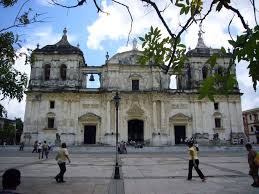This weekend, SchuMustTravel finds herself in LEON (how does one *do* accents when blogging in America? there’s supposed to be one over the “O”), Nicaragua. From Wiki:
León is the second largest city in Nicaragua, after Managua. It was founded by the Spaniards as Santiago de los Caballeros de León and rivals Granada, Nicaragua [where Schu heads tomorrow], in the number of historic spanish colonial homes and churches…
León is located along the Río Chiquito (Chiquito River), some 50 miles northwest of Managua, and some 11 miles east of the Pacific Ocean coast. The drive from Managua takes less than 90 minutes. Although less populous than Managua, León has long been the intellectual center of the nation, with its university founded in 1813. León is also an important industrial, agricultural (sugar cane, cattle, peanut, plantane, sorghum) and commercial center for Nicaragua.
The first city named León in Nicaragua was established in 1524 by Francisco Hernández de Córdoba about 20 miles east of the present site. The city was abandoned in 1610, after an eruption of the Momotombo volcano, located only a couple miles away, which left extensive damage in the form of flooding from Lake Managua. The inhabitants decided to move to its current location next to the Indigenous town of Subtiava. The ruins of the abandoned city are known as "León Viejo" and were excavated in 1960. In the year 2000, León Viejo was declared an UNESCO World Heritage Site.
León has fine examples of Spanish Colonial architecture, including the grand Cathedral of the Assumption, built from 1706 to 1740, with two towers added in 1746 and 1779.
When Nicaragua withdrew from the United Provinces of Central America in 1839, León became the capital of the new nation of Nicaragua. For some years the capital shifted back and forth between León and Granada, Nicaragua, with Liberal regimes preferring León and Conservative ones Granada, until as a compromise Managua was agreed upon to be the permanent capital in 1858.
In 1950 the city of León had a population of 31,000 people. Nicaraguan President Anastasio Somoza García was shot and mortally wounded in the city on September 21, 1956.
The building of El museo de tradiciones y leyendas was once the infamous XXI jail before the 1979 revolution. There are also several political murals around the city.






